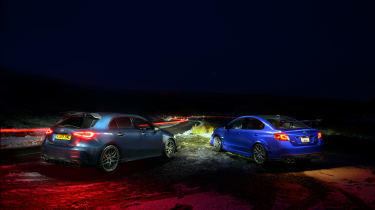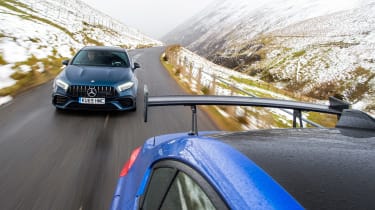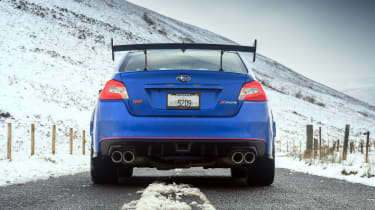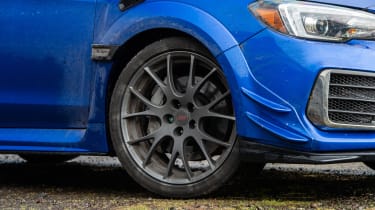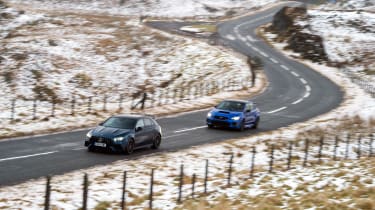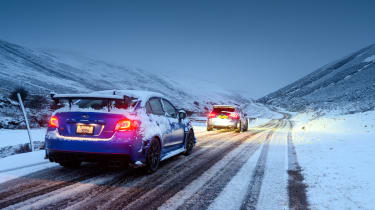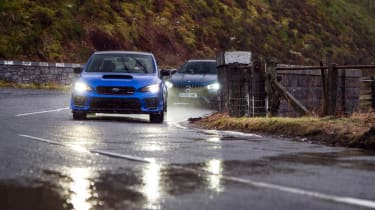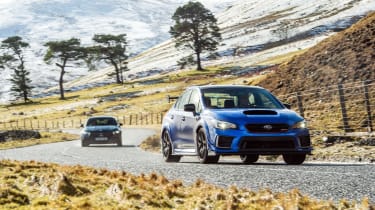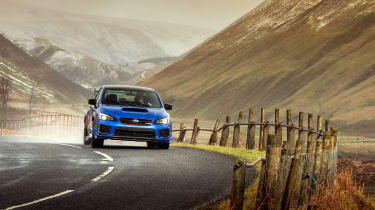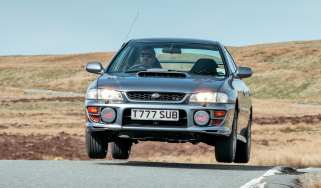Mercedes‑AMG A45 S v Subaru Impreza WRX STI S209
Two decades ago, hardcore Subarus ruled the roads, so can the latest WRX STI S209 show Mercedes‑AMG’s A45 S – a 21st-century spiritual successor to those indomitable Imprezas – a new trick or two?
'It’ll be like the old days,’ says Dickie Meaden on the other end of the phone. It’s Friday evening, and I’m sitting with a glass of wine in hand trying to work out the logistics of getting a fresh sumpful of exotic Motul race oil into a rather special Subaru in the wilds of Dumfries with not even so much as a day’s notice. We don’t even have the blasted oil yet, let alone somewhere to swap it out on Monday afternoon.
‘Back then we’d be in the latest hardcore grey import Impreza, gunning it to north Wales with the importation documents still on the front seat,’ he continues. ‘There was always a race between magazines to see who could get the latest Japanese-spec Subaru or Mitsubishi first. They were “the thing” at the time – vaguely affordable, able to work as a family car, but a humble mid-sized Japanese saloon that could worry a supercar in poor weather and/or on the right kind of road by dint of all-weather traction and seeming imperviousness to bumps, crests and surface changes that would pull the rug out from underneath an edgy, low-slung, mid-engined supercar.’
> Subaru BRZ (2012 - 2021) review – can it match the Mazda MX-5?
They were indeed special times, and as an impressionable young-ish reader of the magazine back then, I remember the arms race well. But like any era there was a beginning, peak and an end, a waning that in this case began in the mid-noughties and was pretty much all over by the start of the past decade. Subaru has kept the faith, Mitsubishi has not, but in the UK at least, the genre has shrunk to near extinction in the new performance car market.
So what on earth happened?
A gulf opened between the road cars and rallying, which didn’t help, but crucially, no longer did you need to put up with the downsides of Impreza or Evo ownership – the questionable styling additions, low-rent interiors, higher fuel consumption and more frequent servicing – to have a fast, practical and reasonably affordable performance car. When the Turbo 2000 Impreza first appeared, a top hot hatch such as the Clio Williams made 150bhp, but the birth of the modern turbocharged hot hatch soon rendered Imprezas somehow antiquated, obsolete, and rather old-fashioned. Sure, there was still a place for them, but for most buyers cars such as the Golf R offered all they needed in a slicker, more acceptable and simply less demanding package.
However, while Subaru’s independent UK importers have had very little interest in performance cars or their brand’s heritage for many years, over in America things are rather different. Subaru America, a subsidiary of the mother company, sells over 700,000 cars a year and enjoys a cult following for its current WRX and WRX STI models. That goes a long way to explaining why this final ‘S’ example of the VA-generation WRX STI is a 209-run model for the American market only.
It had seemed impossible that we’d get our hands on an S209, but thanks to the amazing generosity of evo reader David Price, who you may recall from the Fast Fleet with his Camaro Z/28 a few years ago, just a few days before we head north a fresh-off-the-line S209 is unloaded at Liverpool docks and then partly run-in by its enthusiastic owner over some great Welsh roads before arriving at evo Towers II.
I bag the Mercedes-AMG A45 S for the journey up to Scotland and feel a little smug as Dickie gets comfortable in the left-hand seat of the Subaru and steps back to 1998… It’s far from just a go-faster STI, like 2018’s Final Edition model for the UK was. Behind the jutting front splitter and comedy Time Attack-style rear wing is a stiffer and 48mm wider body covering 15mm wider tracks front and rear, with unique suspension tuning and sticky Dunlop Sport Maxx tyres on forged 19-inch BBS rims. It’s a six-speed manual only, with electronically controlled but driver-adjustable front, centre and rear differentials, torque vectoring and new six-pot front calipers to improve stopping power and endurance. The roof is carbon and there are just two colours schemes available: blue with grey alloy wheels, or white with gold. The engine has received plenty of attention too. With a new, larger HKS turbocharger, bigger fuel injectors, a new induction system, more boost and a driver-operated intercooler water spray, it makes 341bhp and 330lb ft of torque. Impressive, but figures that rather pale alongside the ferocious AMG’s.
Ah yes, the A45. As much as I want to tear my hair out at the unbelievable complexity and needless options of its full MBUX digital cockpit, I am also instantly reminded over the first few yards of what a special car this really is, even if the headbanger S209 has the effect of making it look like a PCP-tastic A180.
So it looks much like an A35. And yes, like that car it features a 2-litre turbocharged engine, four-wheel drive, and a dual-clutch ’box, all wrapped up in an aggressive hatchback body (especially so if fitted with the optional aero kit). But the reality is that it isn’t like an A35 AMG at all. The 415bhp and 369lb ft motor is a bespoke AMG engine, not a superheated Mercedes one, and much of the fundamental work that went into making the A35 a decent hot hatch has then been capitalised on here to create something that exists on a much higher plain. Its ride quality and composure are astounding, because it feels supple, friction-free and beautifully poised with the dampers in their Comfort setting, and even with them in their most aggressive it still rides more deftly than an A35 in its softest set-up. It has an unusually oily precision to the way it steers as well – all small but not so subtle clues that the full force of AMG’s engineering might has been pumped into the 45. Then you open the taps for the first time and it springs forward like a crossbow bolt being fired and there’s no ambiguity about anything: it’s an absolute animal.
That brings us neatly to why these two are vying for supremacy in the first place. Once upon a time, on a B-road far away, the hardcore Impreza was pretty much the quickest way of getting from point A to point B. Plenty of us wonder whether the A45 is the rebirth of such a car, remixed for the ’20s. If that is indeed so, how does it compare with the last and greatest offering of Subaru’s current generation? Will one make the other look old? Will one make the other seem uninvolving?
There’s no way we’re going to make it to AF Noble and Son of Penicuik – the Subaru dealer that I’ve lined up for our necessary 1000-mile oil change – in time this evening, so it’s straight to our location in the mountains and some of the foulest weather I can remember on a shoot.
There are so many possible drive settings in the 45, but I prefer to switch between just two of them: Comfort, for pottering around and motorway cruising, and an Individual setting that combines maximum attack for most things with medium Sport damping and a quieter exhaust. The 45 is a real chameleon in this regard, meek enough that debadged and sans aerokit it could slip around virtually unnoticed right up to the point you flick the little plastic switch forward to Individual.
The last time a car with a hatchback body felt this rear-drive must surely have been the early 1980s and the era of the Chevette HS and the Talbot Sunbeam Lotus. Seeking to experience the sensations to the max I disable the ESP and set about chasing Dickie up and down the mountains; we may still be keeping the revs down in the 209, but the way it gets a move on is deeply impressive.
At no time does the 45 appear to want to understeer, even with small lakes of standing water and patches of strewn gravel from the wintry battering the road has received. Instead, and particularly under power, you can feel the loaded rear wheel overworking. Most of the time this results in a sharpening of line, a devastatingly effective snap of the car into the turn – you’re never a hostage to front-end traction like you might be in a conventional hot hatch. But sometimes, especially in slow and medium-speed corners, it’s enough to flick the rear of the car into oversteer, the sort that requires a proper steering input to deal with. This isn’t the kind of four-wheel-drive set-up that instinctively and abruptly pulls the nose straight – it needs you to be on it. In these conditions and at this pace, it’s wild.
The 45’s raw performance doesn’t come at the expense of numbness elsewhere, but there’s something about the frenzied experience that puts outrageous pace at the forefront, and actual enjoyment a little further out of focus. ‘I think the AMG is the more immediately seductive as an all-round proposition,’ reckons Dickie, ‘because it goes like the clappers, but also surrounds you in a higher degree of comfort and quality. If I have a criticism it’s that there’s not a great deal of driving nourishment. Driving it fast along a challenging road is a bit like eating fast food when you’re starving hungry – instant gratification that hits the spot, but is quickly forgotten until the next craving.’ Hmm, maybe a little harsh in my book, but I know what he means. The lower gears of the eight-speed ’box feel so short, if you’re shifting manually with the sturdy silver paddles you almost need to hook third before your fingers have completed the snap to select second. That rush is partly due to the engine, though, which positively screams around to the 7000rpm red line in a blur of explosive energy. It is so, so deeply rapid.
Just a couple of times the AMG nearly bites, hitting a bump and skating on a puddle at the corner’s exit, requiring a sudden grab of lock and an equally rapid straightening of the wheel to then prevent the nose suddenly spearing off into the parallel rock face. This isn’t your normal hot hatch experience, oh no…
Our impending oil change means an early start the next morning. You always know when it’s snowing, don’t you, even in the pitch darkness. As I open my eyes the silence is so complete it’s suspiciously quiet even for this tiny, remote village. Sure enough, there’s three inches of snow outside the window, and it’s still falling heavily. Crunching underfoot over to the Subaru, its Dunlop boots suddenly seem wholly inappropriate. Still, there’s nothing as reassuring as a good old Scooby. The thrum and rocking motion imbalance of the flat-four immediately strikes a chord with the soul, the Ultrasuede-clad wheel feels delightful, and the interaction of the manual ’box helps stir me from pre-breakfast lethargy.
After our rapid visit to Penicuik it’s time to head in a southerly direction, the roads clear of the white stuff but lashed with wind and rain, and booby-trapped with vicious potholes. It is the ultimate test of a driver’s car, and perfect terrain and conditions for this pair.
Right at this moment, the 209 is puzzling me. It just doesn’t feel right. Chiefly, the engine is immediately underwhelming, particularly given the work that’s gone into its increased potency. I am on the throttle as much as I dare, but the engine’s response to it feels mushy, and nothing much at all happens below 3500rpm. Above that it hardly hits with a wallop, and it’s quiet enough in induction and exhaust noise that the sound of the standing water blasting the underside and general tyre noise mask it to the point where I’m not even sure what revs we’re pulling. However much I subtly adjust the pressure of my right foot there seems to be just two speeds: off, and on boost, and very little in between.
Neither do I have a great deal of confidence that the front end is going to stick, and there’s a surprising amount of torque-steer under acceleration, to the point where I confess the 209 is driving me as much as I’m driving it. Somewhere in the distance the A45 has disappeared in a giant rooster tail of freezing water and I have to let it go; I’m far too busy correcting the 209, avoiding the alarming gaps in the asphalt, just keeping the thing on the straight and narrow.
When we pull up next to the loch I shoot Dickie a glance that translates as: ‘Er… am I missing something here?’ So it’s a relief when I discover that his thoughts are broadly in line with mine. ‘In peak terms it has a deficit of 70-odd horsepower and 39lb ft, but factor-in the lag and there are undoubtedly many times where the permanently simmering Merc has two or three times that advantage when you get back on the power. All of which places a heavier emphasis on technique and timing to get the Subaru stoked.’ If anything, it simply reaffirms my admiration for what AMG has achieved with this new motor, truly the daddy of in-line turbo fours.
‘The S209 also has that Impreza thing of not telling you enough about the front end just at the point you’re turning in,’ continues Dickie. ‘This is familiar territory to a seasoned Impreza driver, for they’ve always been a bit glassy when you make your initial steering input. You know where you are once the outside front wheel is loaded, but because Imprezas also tend towards understeer, the early sensation is that you’ve carried too much speed.
‘The trick is knowing whether you really have been horribly optimistic, or whether you simply need to bully it a bit more so the front end bites. When you’ve got it right you can apply more throttle and feel the front diff counter the understeer and tighten the line. When you’re really on it the S209 pulls its way out of a corner with real aggression, even torque-steering like a front-drive car, only without the wheelspin.’ Maybe it’s just a confidence thing, then.
In truth it takes a couple of hours to really feel at home in the S209, but when it clicks, man does it suddenly come alive. Where the AMG is always just a twitch away from rotating under power, the 209 has that delicious Subaru sensation of all four wheels constantly straining to deliver absolute peak traction. I flick the centre diff to bias the rear, and the steering calms – enough for me to forget about any unruliness that once was. It’s far from a sideways machine, but once you’re in the groove the 209 is beautifully neutral, especially if you work the uprated brakes hard on corner entry. There’s a small but appreciable amount of body roll and pitch, more than with the AMG, but it’s always carefully regulated, so that with every input you feel the same shift of attitude.
I’m sure the Dunlops don’t help – after all, they’re aimed at trackdays and warmer climes – and it’s hard to get them to key into the surface (a major disadvantage compared to the AMG’s Michelin 4 Ss), but as with the turn-in, once you’ve accepted that the fronts will skate and then re-grip on standing water, it’s no big deal. The hydraulic steering assistance provides a more authentic build-up of weight away from the straight-ahead and more natural self-centring, and once you’ve unlocked that flow the 209 just dances along – particularly satisfying through a sequence of fast curves.
Despite the greater initial body movement the Subaru’s suspension is a little less tolerant of major intrusions, again feeling biased a little more to track work than the AMG, but both cars have an ability to shrug off even the worst this most demanding of roads has to offer. Put it this way: you’re never worried about the nose of either, despite the rollercoaster topography.
I simply can’t conceive anything on four wheels being faster on this road than an A45 AMG. Its matrix of acceleration, traction, grip, braking and chassis adjustability congeal into a form of madness that will suck you into an abyss of trouble should you not be able to resist. As Meaden says with more than a little trepidation: ‘The only limitation to the speed it will carry down a road is how much rope you’re willing to give yourself. Of course, that’s what we used to say about Imprezas and Evos, but that now requires a rethink.’ In the 209, gear choice is everything, for to let it drop out of its favoured 4000-6000rpm band is to invite torpidity back into the driving experience. But the six-speed ’box – with that classic Subaru two-stage ratchet feel and slight lateral looseness – gives so much more involvement than the Merc’s paddles, and timing a single heel-and-toe just right is more satisfying than ten years of flicking your fingers. And once you’re on it in the 209 it won’t let the AMG’s rump disappear – the Subaru is always carrying more speed than it feels, and you’ll be having more fun at the same time.
‘I don’t think I’ve driven a pair of cars that would appear to share so much and are on sale at the same time for broadly the same money, yet go about their business in such different ways,’ opines Meaden as the day grows long. For both of us, the more time we spend in the Subaru, the more we adore it, whereas our respect is 100 per cent for the AMG but our love seems to have stalled at a certain point, not to rise further.
Each car has plenty to learn from the other. Neither is perfect: the STI would come alive with a high-revving EJ20 in it; the Merc with another layer of involvement and a decluttering of ‘premiumness’.
‘If you could combine the best bits of the two into one fierce, fast and characterful car [preferably with a manual option] and sell it for £50k you’d have something truly epic,’ is Dickie’s summation.
There’s an all-new WRX STI on the way, they say with as much as 400bhp. Subaru doesn’t need to start from scratch; its unique way of making driver’s cars is as appealing as ever. It just needs a remix into the modern world, and perhaps then we’ll have a new era of the supercar slayers for every man.
|
Mercedes-AMG A45 S |
Subaru Impreza WRX STI S209 | |
| Engine | In-line 4-cyl, 1991cc, turbocharged | Flat-four, 2457cc, turbocharged |
| Power | 415bhp @ 6750rpm | 341bhp @ 6400rpm |
| Torque | 369lb ft @ 5000rpm | 330lb ft @ 3600rpm |
| Weight | 1560kg | 1580kg |
| Power-to-weight | 270bhp/ton | 219bhp/ton |
| 0-62mph | 3.9sec | <5.0sec |
| Top speed | 167mph | n/a |
| Basic price | £50,570 | $63,995 (£50,000) |

